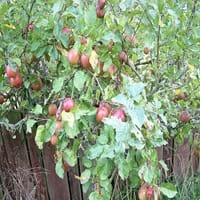Life Span
Perennial
Perennial
Type
Flowering Plants, Shrubs
Fruit
Origin
Central Asia, China, Northern America, The Hiamalayas
Eastern Europe, Southern Europe, Russia/Siberia, Southern Asia, Western Asia
Types
Bigleaf hydrangea, Hortensia, Smooth hydrangea, Oakleaf hydrangea, Annabelle
Not available
Number of Varieties
Not Available
Habitat
Forest edges, Hillside, Woods
Hillside, Mountain Slopes, Temperate Regions
USDA Hardiness Zone
3-8
4-8
Sunset Zone
21,22
2a, 2b, 3a, 3b, 7
Habit
Arching/Fountain-shaped
Oval or Rounded
Flower Color
Blue, Dark Purple, Light Purple, Red, White
White, Rose
Flower Color Modifier
Bicolor
Bicolor
Fruit Color
Not Available
Yellow, Red
Leaf Color in Spring
Dark Green
Green
Leaf Color in Summer
Light Green
Green
Leaf Color in Fall
Several shades of Green
Green, Light Yellow, Brown
Leaf Color in Winter
Light Green
Light Green
Leaf Shape
Oblovate
Oblong
Plant Season
Early Spring, Late Autumn
Spring, Fall
Sunlight
Full Sun, Partial Sun, Partial shade
Full Sun, Partial Sun, Partial shade
Growth Rate
Medium
Medium
Type of Soil
Light
Clay, Loam
The pH of Soil
Acidic
Acidic, Neutral
Soil Drainage
Average
Well drained
Bloom Time
Summer, Late Summer, Early Fall
Early Spring, Spring
Repeat Bloomer
Insignificant
No
Tolerances
Drought
Drought
Where to Plant?
Container, Ground
Ground
How to Plant?
Seedlings, Stem Planting
Grafting, Seedlings, Transplanting
Plant Maintenance
Medium
Medium
Watering Requirements
Not Available
Medium
In Summer
Lots of watering
Lots of watering
In Spring
Moderate
Moderate
In Winter
Average Water
Average Water
Soil pH
Not Available
Acidic, Neutral
Soil Type
Not Available
Clay, Loam
Soil Drainage Capacity
Average
Well drained
Sun Exposure
Full Sun, Partial Sun, Partial shade
Full Sun, Partial Sun, Partial shade
Pruning
Remove damaged leaves, Remove dead branches, Remove dead leaves
Remove damaged leaves, Remove dead branches, Remove dead leaves
Fertilizers
All-Purpose Liquid Fertilizer
All-Purpose Liquid Fertilizer
Pests and Diseases
Red blotch
Black rot, Leaf spot, Scab
Plant Tolerance
Drought
Drought
Flower Petal Number
Single
Single
Showy Foliage
Insignificant
No
Foliage Texture
Medium
Medium
Foliage Sheen
Not Available
Matte
Evergreen
Not Available
No
Invasive
Not Available
No
Attracts
Butterflies
Birds
Allergy
Chest tightness, Diarrhea, Dizziness, Nausea, Vomiting
Mouth itching, Throat itching
Aesthetic Uses
Not Available
Not Used For Aesthetic Purpose
Beauty Benefits
Not Available
Not Available
Edible Uses
Not Available
Yes
Environmental Uses
Air purification
Air purification
Medicinal Uses
Fever, Kidney problems, Urinary tract problems
Cancer, constipation, Diabetes, Diarrhea, Dysentry, Fever, Heart problems, Tooth ache
Part of Plant Used
Flowers, Root
Fruits
Other Uses
Not Available
Used As Food, Wood is used for making furniture
Used As Indoor Plant
Not Available
No
Used As Outdoor Plant
Yes
Yes
Garden Design
Mixed Border, Wildflower
Edible, Feature Plant, Fruit / Fruit Tree
Botanical Name
GEUM rivale
MALUS domestica 'Jonathan'
Common Name
Chocolate-root, Indian Chocolate, Water Avens
Apple, Eating Apple, Jonathan Apple
In Hindi
Hydrangea
जोनाथन सेब
In German
Hortensie
Jonathan (Apfel)
In French
Hortensia
Jonathan (pomme)
In Spanish
Hortensia
Jonathan manzana
In Greek
υδραγεία
Jonathan μήλο
In Portuguese
Hortênsia
Jonathan maçã
In Polish
Hortensja
Jonatan (jabłko)
In Latin
Hibiscus
Apple Ionathan
Phylum
Not Available
Magnoliophyta
Class
Not Available
Magnoliopsida
Order
Not Available
Rosales
Genus
Not Available
Malus
Clade
Not Available
Angiosperms, Eudicots, Rosids
Tribe
Not Available
Not Available
Subfamily
Not Available
Not Available
Number of Species
Not Available
Not Available
Importance of Chocolate-root and Jonathan Apple
Want to have the most appropriate plant for your garden? You might want to know the importance of Chocolate-root and Jonathan Apple. Basically, these two plants vary in many aspects. Compare Chocolate-root and Jonathan Apple as they differ in many characteristics such as their life, care, benefits, facts, etc. Every gardener must at least have the slightest clue about the plants he wants to plant in his garden. Compare their benefits, which differ in many ways like facts and uses. The medicinal use of Chocolate-root is Fever, Kidney problems and Urinary tract problems whereas of Jonathan Apple is Cancer, constipation, Diabetes, Diarrhea, Dysentry, Fever, Heart problems and Tooth ache. Chocolate-root has beauty benefits as follows: Not Available while Jonathan Apple has beauty benefits as follows: Not Available.
Compare Facts of Chocolate-root vs Jonathan Apple
How to choose the best garden plant for your garden depending upon its facts? Here garden plant comparison will help you to solve this query. Compare the facts of Chocolate-root vs Jonathan Apple and know which one to choose. As garden plants have benefits and other uses, allergy is also a major drawback of plants for some people. Allergic reactions of Chocolate-root are Chest tightness, Diarrhea, Dizziness, Nausea and Vomiting whereas of Jonathan Apple have Mouth itching and Throat itching respectively. Having a fruit bearing plant in your garden can be a plus point of your garden. Chocolate-root has no showy fruits and Jonathan Apple has showy fruits. Also Chocolate-root is flowering and Jonathan Apple is not flowering . You can compare Chocolate-root and Jonathan Apple facts and facts of other plants too.

